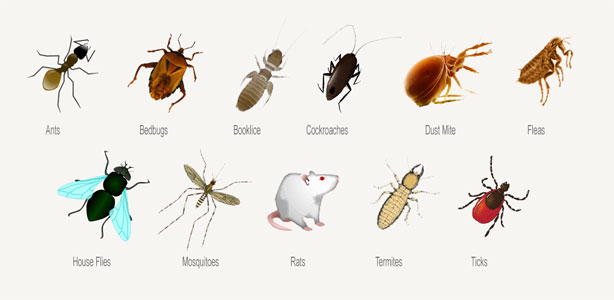A pest can be described as any organism capable of causing damage to crop plant.

Types of Crop Pest.
Important pests of crop plants are grouped into the following classes:
(i) insect; (ii) birds; (iii) rodents; (iv) monkeys; (v) man; (vi) nematodes
CLASSIFICATION OF INSECT PESTS
Insects pests can be classified into various groups based on their mode of feeding. These groups of insect pest include:
IMPORTANT PEST OF MAJOR CROPS
| Insect Pest | Crops Attacked | Nature of Damage and Economic Importance | Prevention and Control Measure |
| Stem burrower | Cereals e.g. rice, maize, guinea corn | i. Larvae bore holes into stems. ii. They eat up the plant iii. They weaken the plant iv. Reduced growth and yield | i. Uproot and burn infected plant. ii. Spray with insecticides e.g. Gammlin 20. iii. Early planting iv. Crop rotation. |
| Army Worm | Cereals e.g. maize | i. Larvae invade and eat up leaves and stem ii. Reduce photosynthesis iii. Retarded growth iv. Reduced yield | i. Hand picking ii. Spray with insecticides e.g. DDT.
|
| Pod Burrower | Legumes e.g. cowpea, soyabeans | i. Larvae bore into the pod. ii. They eat up the seeds. iii. Reduced yield iv. Introduce disease | i. Crop rotation ii. Early harvesting iii. Spray with insecticides |
| Aphids | Legumes e.g cowpea, soyabeans | i. Stunted growth ii. Galls on leaves iii. Vectors of disease e.g. rosette, mosaic disease of cowpea | i. Spray with insecticides to kill vector ii. Uproot and burn infected plant
|
| Leaf beetle | Legume e.g. cowpea soyabeans | i. They eat up the leaves ii. Reduce photosynthesis iii. Reduced yield | i. Spray with insecticides ii. Use resistant varieties
|
| Cocoa mirids (capsids) | Beverages e.g. cocoa | i. They inject toxic saliva into plant ii. Transmit fungal diseases iii. Reduced yield iv. Stunted growth | i. Spray with insecticide e.g. Gammalin 20 ii. Regular weeding |
| Yam beetles | Tubers e.g. yam | i. Bore holes into yam tubers ii. Reduction in yield iii. Reduction in quality and market value | i. Dust yam sets with Adrin dust before planting ii. Crop rotation |
| Cassava mealybugs | Tubers e.g. cassava | i. Twisting of stem and reduce internodes ii. Swelling of shoots iii. Reduced yield | i. Early planting ii. Use resistant varieties iii. Cutting treatment iv. Spray with insecticides |
| Green spidermite | Tuber e.g. cassava | i. They feed on the leaves ii. Reduce rate of photo synthesis iii. Reduction in yield | i. Use biological control ii. Spray with insecticides. |
| Variegated grasshopper | Tubers e.g. cassava, yam | i. Adults and larvae eat up the leaves and stem ii. Reduce the rate of photosynthesis iii. Reduced growth iv. Reduced yield | i. Hand picking ii. Spray with insecticides e.g. Adrex 40. |
| Cotton stainer | Cotton | i. They pierce and suck sap from plants. ii. Produce toxic saliva iii. Transmit diseases. iv. Reduce quality of boll v. Leaf distortion | i. Hand picking ii. Spray with insecticides. |
| Cotton bollworm | Cotton | i. Larvae feed on the seeds of cotton ii. Crop rotation iii. Destroy the lint and reduce its quality iv. Premature fall of cotton boll. | i. Spray with insecticides to kill insects. ii. Burn cotton plant debris after harvesting. |
| Thrips | Vegetables e.g. onion, tomato | i. Browning of leaves ii. Wilting of plant iii. Reduced yield | i. Spray with insecticides. |
| Leaf rollers
Leaf beetle | Vegetable
Vegetables e.g. pepper, okro, tomato | i. Rolling and twisting of leaves. ii. Reduction in rate of photosynthesis. iii. Reduce yield iv. They eat up the leaves and stems v. Reduced photosynthesis vi. Reduction in yield and quality | Spray with insecticides e.g. Vetox 85.
Spray with appropriate insecticides e.g. Vetox 85 |
| Bean beetle, grain weevils | Stored produce e.g. rice, cowpea, maize | i. Bore holes into grainsand eat them up. ii. Reduce the quality of stored produce iii. Reduce quality of grains to powder iv. Reduce farmer’s income v. It reduces the market value of grains vi. It reduces viability of infested grains. | i. Early harvesting ii. Proper storage of produce iii. Proper cleaning and fumigation of store with phostoxin tablets or with lindane dust iv. Store grains over fire places v. Proper drying of seeds to reduce moisture content and kill the eggs and larva of pest. |
| Birds | Rice, maize, millets, sorghum | i. Feed on grains in the field ii. Reduction in quality and yield iii. Reduction in income of farmer | i. Use of bird scarer or scare cow. ii. Use of cage traps with baits iii. Drumming or noise making on the farm iv. Shooting with catapult v. Use of explosive mechanism at regular intervals vi. Use of avicides vii. Fencing/screening farms in greenhouse. |
| Rodents e.g. bush rabbit, rats, squirrel | Rice, yam, cassava, fruits | i. They feed on crops ii. Destroy whole plants iii. Reduction in yield iv. Increase in cost of production | i. Trapping with baits ii. Use of rodenticides iii. Use of string/wire tapes iv. Use of predator e.g. dogs and cats v. Clean weeding of farms vi. Shooting and fencing vii. Use of pit traps. |
| Monkeys | Cocoa, mango, banana, orange. | i. They eat up the fruits ii. Reduce the quality of fruits iii. Losses to the farmer | i. Use traps ii. Shooting with gun where possible |
EFFECTS OR ECONOMIC IMPORTANCE OF INSECT PESTS IN CROP PRODUCTION
Read our disclaimer.
AD: Take Free online baptism course: Preachi.com 